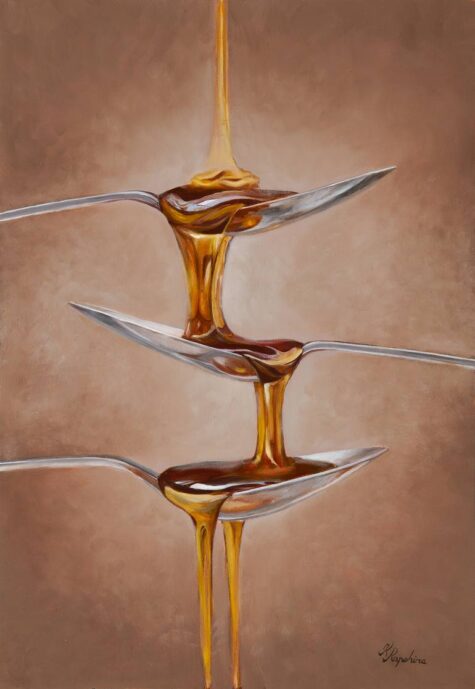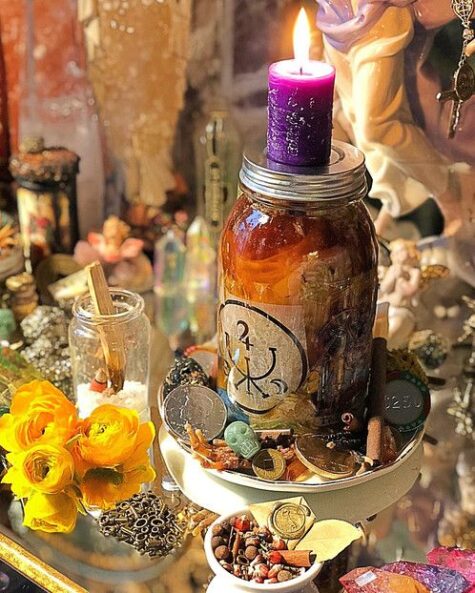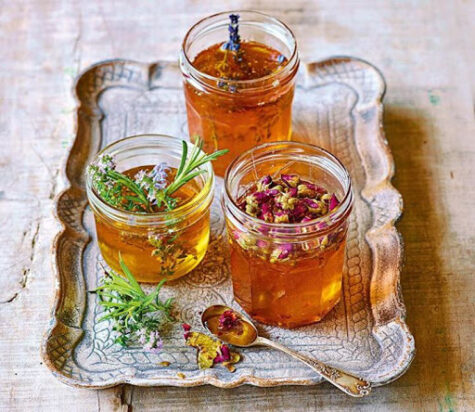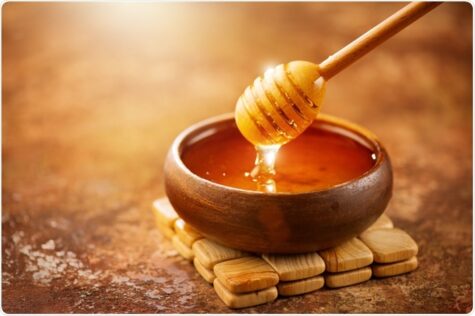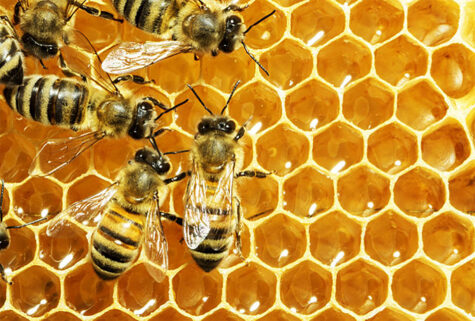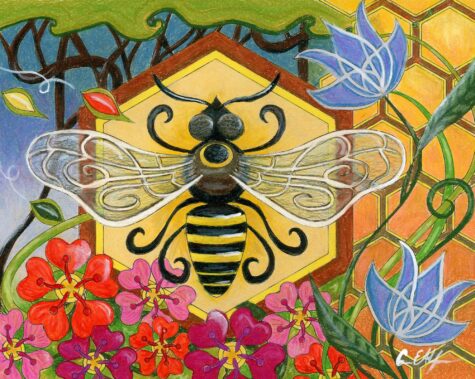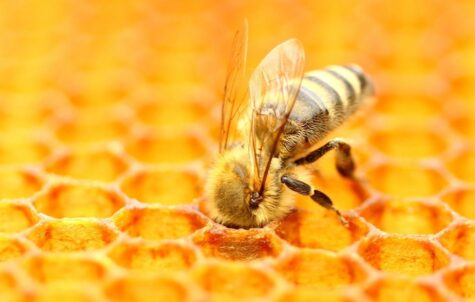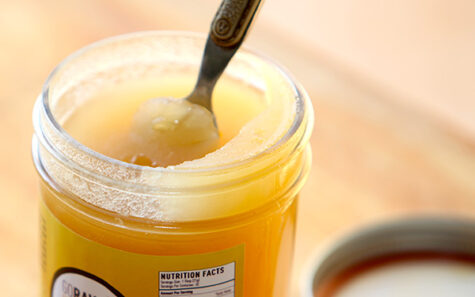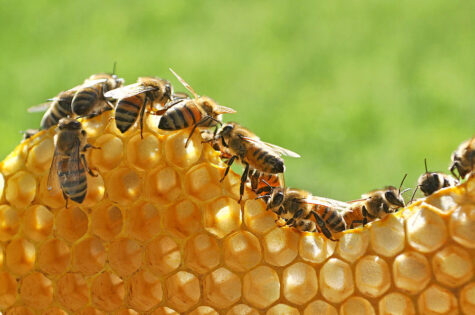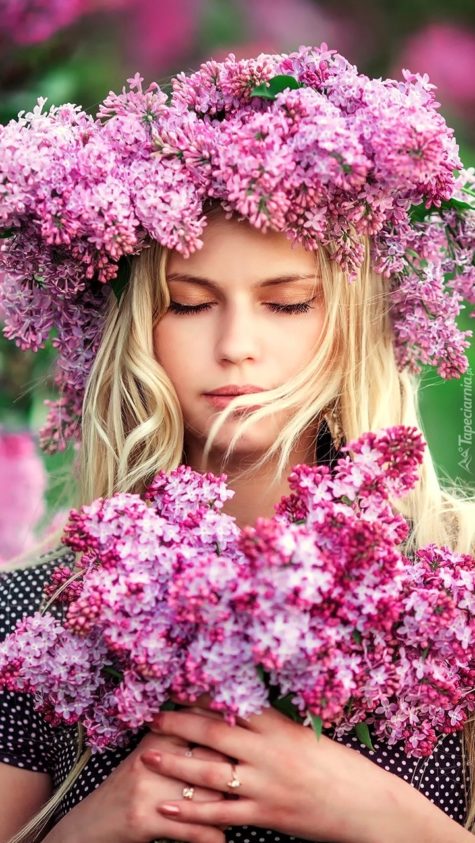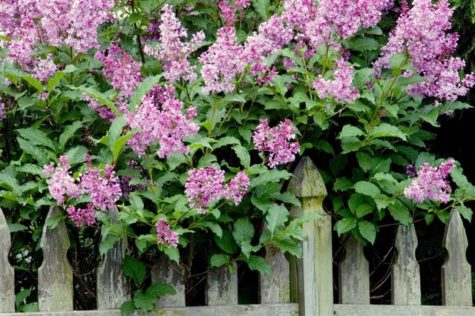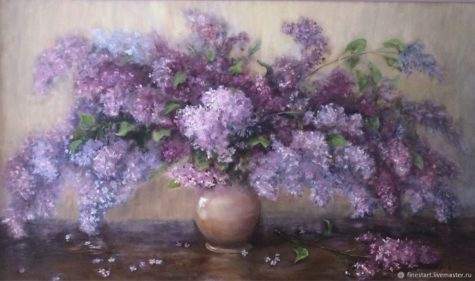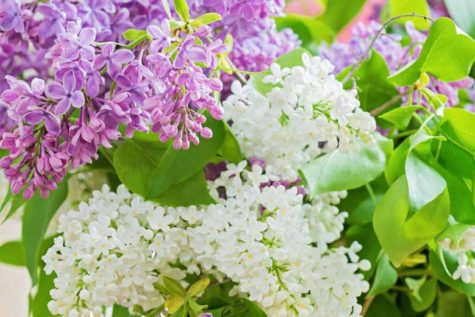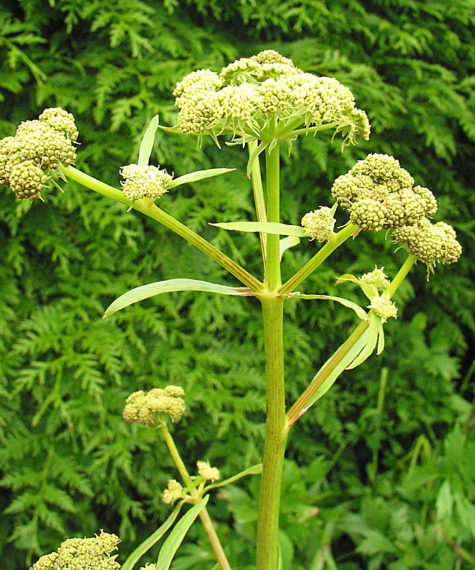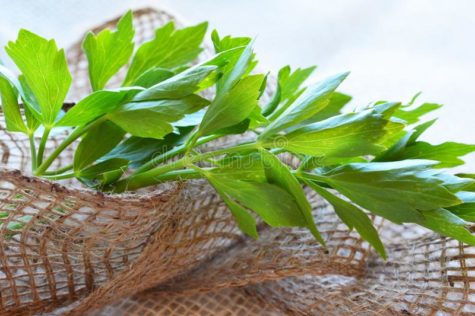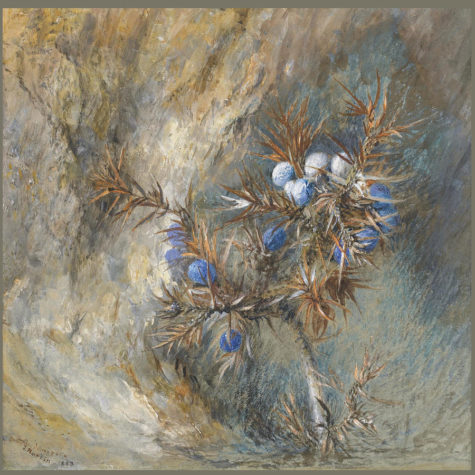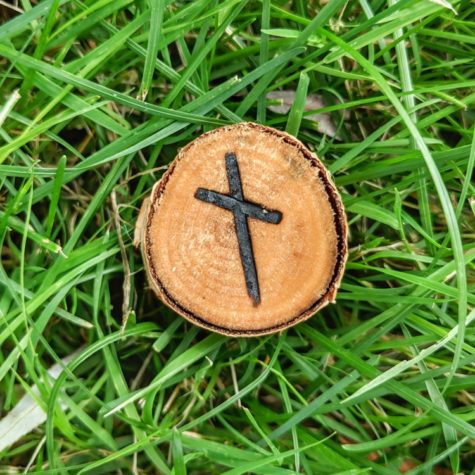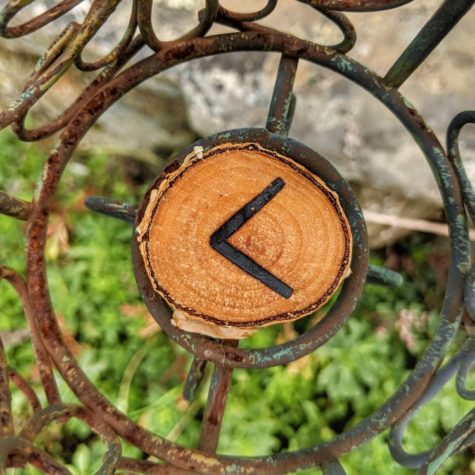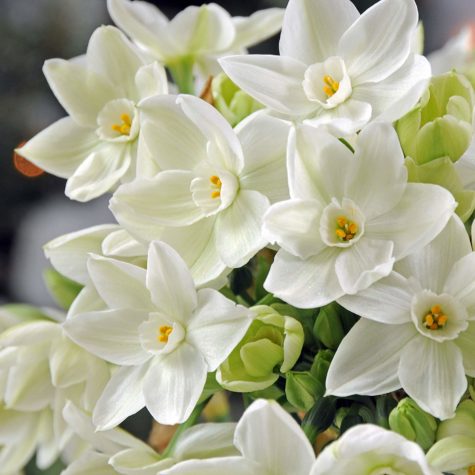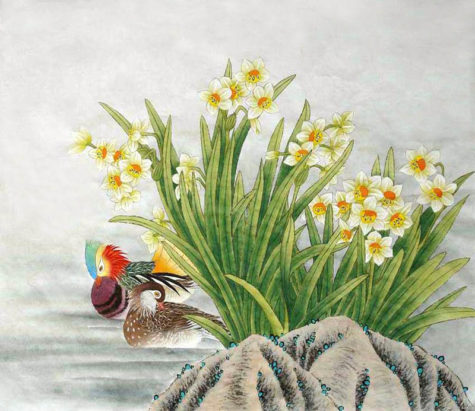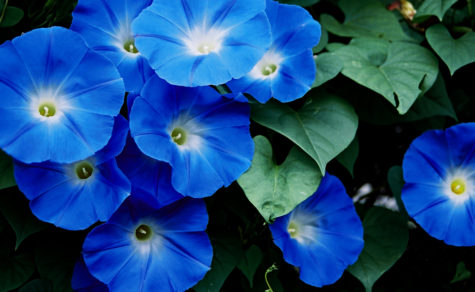Love
- Rulers: Oshun, Ra, Vishnu, Krishna, Aphrodite
- Element: Water, Earth
- Gender: Feminine
- Number: Six
- Sacred Geometry: Hexagon
- Type: Food
- Magickal Form: Any type
- Qualities: Sweetening, Binding, Happiness, Healing, Love, Prosperity, Passion, Spirituality, Faerie
Honey – the glorious nectar of the bees is one of the oldest foods known to man…and woman. Honey’s history is extensive. A 8,000 year-old cave painting in Valencia, Spain depicts humans hunting for honey. Honeybees were sacred to numerous ancient civilizations including ancient Greece and Egypt. Our ancient ancestors knew that honey isn’t JUST good to eat, it also has multiple medicinal benefits.
The oldest honey ever found comes from an Egyptian pyramid – it’s three thousand years old and still perfectly edible! Microbes don’t grow on honey, moreover preservation lasts for thousands of years!
The Egyptians held the honeybee in high regard and used honey in their mummification process. Therefore honey was a sacred substance and sacred to any gods and goddesses of the underworld and the dead: i.e. Anubis and Osiris. In Ancient Greece, the high priestess of Aphrodite was “Melissa” which translates to “bee”. She tended to the sacred beehives at Aphrodite’s temple on Mount Eryx.
Honey has a number of magickal proprieties, uses and distinct energies. the energies vary depending on which strain of honey you are working with. but overall I would describe them as positive, cleansing, gentle, soothing and warming. its great for spells, offerings and brews.
Honey can be added to any spell work or any culinary recipe to sweeten someone’s mood or disposition. Honey works well for happiness, love, prosperity and healing, it can also add a bit of zing to your love life too.
- Honey makes an acceptable offering for deities.
- It can be kept on your altar (I keep some on my altar to remind me that amongst the seemingly overwhelming bitterness of everyday life that sweetness can be found).
- Can be used in spells having to do with love, lust or sexuality.
- Purification (works great in bath scrubs).
- Health and healing.
- Community or communication.
- Abundance and prosperity.
- Spirituality.
- Candle magic (for anointing or beeswax candles).
- Honey can be used to represent wisdom, because gathering honey from hives can be difficult and painful if done incorrectly so it became a metaphor for obtaining knowledge through pain.
Honey is used to make mead which is absolutely delicious and wonderful to use in ritual and offerings…half a glass and I am away with the faeries…who actually like a drop of mead or honey as well…
Because of its sticky properties, honey can be used in magick to hold two things together. Some magical traditions use honey to bind a couple that has a shaky relationship. If you want to do a honey binding on a couple – or even on two friends who are struggling with their friendship – you can use poppets with a layer of honey between them, and then wrapped with a cord. Because honey does not solidify, you can always separate the two poppets later with minimal disruption. It’s good for binding spells because it can be undone fairly easily.
Use honey to sweeten a situation: angry co-workers or boss, court cases, family quarrels, divorces, etc. In addition, binding things or people together and keeping things flowing steadily. Healing and cleansing rituals include honey.
Use this sweet and sticky substance to attract good fortune, fertility, and love.
- For wealth, create an altar with coins drizzled with honey.
- For a conception spell, cover a pumpkin with honey and offer to a river.
- For love, bathe in warm water and honey.
- Add a drop of honey to incense blends to sweeten the mood.
- Add a spoon of honey to a bath to cleanse and sweeten your aura.
- Drip small drops of honey onto or around candles for love and prosperity spells.
- Leave on outside altars to attract faeries.
- Use to summon angels and light beings.
- Anoint your third eye with magical honey to dream of your future love.
If you do any kitchen magick, honey can come in very handy. Use it in dishes to bring about sweetness, fertility, or prosperity. You can use honey in rituals as an offering to deity–many goddesses and gods seem to appreciate it. You can also use a blend of milk and honey to asperge a sacred space if you’re holding ritual outdoors. Add some into a bath scrub for a ritual bath prior to working for love or romance, or anoint a candle with it when you’re doing candle magick.
Some ancient cultures used honey in embalming procedures. It’s always appropriate to leave offerings of honey at a gravesite. In addition, the folklore of a number of societies indicates that a blend of honey and milk is an acceptable offering to a deity. Honey makes an excellent offering to the gods, the spirits and the Faerie world.
Poured into the ocean and river, honey is an appropriate offering to sea and river goddesses like Oshun and Yemaya. Keep on the altar as a link to ancient bee priestesses and honeybee spirit guides.
In particular, honey is sacred to Aphrodite, the goddess of love and beauty. This is also a favorite offering for other love goddesses. An assassination attempt was once made on the African love goddess, Oshun. The plot was to poison her with honey. In remembrance of this, always taste the honey first before offering libations to any goddess.
In Hindu texts, honey is described as one of the five sacred elixirs of immortality. The Buddhist faith celebrates Madhu Purnima, which honors the day that Buddha made peace among his disciples – and honey is given as a gift to monks in his honor.
Honey Jars
These jars are also known as “sweetening jars,” and can actually contain almost any kind of pure sweetener, such as brown or white sugar, molasses, or syrup. You can make jars for each person you want to sweeten if you’re working more elaborate spells on them, or keep one jar with lots of names in it for general sweetening.
In some forms of Hoodoo and folk magick, honey is used to sweeten someone’s feelings towards you. In one traditional spell, honey is poured into a jar or saucer on top of a slip of paper containing the person’s name. A candle is placed in the saucer and burned until it goes out on its own. In another variation, the candle itself is dressed with honey.
Herbal Infused Honey
Honey comes in many forms and from many places all over the world. It varies in color, sweetness, and flavor depending on the region and plants. Some people enjoy infusing herbs and flowers directly into the honey itself. Depending on the herb or flower infused, it will alter the honey magic properties and can be further used for those purposes. For example:
- Lemon balm infused honey: soothes nerves and anxiety and aids in falling asleep; also invokes joy.
- Lavender honey: has honey magic properties of relaxation, love, beauty and purification.
- Rosemary honey: purification, money, love, healing, mental clarity.
- Mint honey: money, prosperity, cleansing, and love properties; plus mint aids digestion.
- Thyme honey: the PERFECT offering for attracting the faery folk to your garden! Thyme is a favorite of fairies as well as honey.
- Rose honey: love, healing, protection, long life.
Medicinal Properties
During the late summer and early fall, honey is a staple crop in many parts of the world. This deliciously sweet and sticky gift from the bee population is considered a health food – it will protect you against allergies if you eat just a teaspoon of locally sourced honey each day – and also has a number of magickal properties.
Honey is incredibly beneficial medicinally but also brings a good dollop of happiness with it. Honey is great for cold and flu treatment. Raw and organic honey is preferable as it is an antibacterial and is high in antioxidants. It can be used in an ointment for treating wounds, burns and cold sores. Honey is also an excellent hangover remedy.
Honey will help in muscle building; a teaspoon of raw organic honey after a workout can induce an insulin spike, allowing your muscles to get the most out of the workout. It can be used as a weight loss aid. Honey can cause changes to the metabolism that will help curb sugar cravings.
The healing power of honey has been known throughout the ages. Honey was used as a traditional Ayurvedic medicine, where it was thought to be effective at treating imbalances in the body. In pre-Ancient Egyptian times, it was used to treat wounds. The Prophet Mohammad glorified the healing powers of honey, and the Quran praised its healing ability.
Sacred Geometry of the Honeycomb
At the heart of our seasonal reverence, there is always light. In the dim light of midwinter we gather around a fire. My children tell me their own creation story of winter’s sleepy sun. It is her time to rest and the small brave fire remains beside us, a comfort in our sun’s absence…
We know winter happens because of the tilt of the earth, and we seek the fire because it warms us. Our winter fires provide one small spark of the sun’s fire. And the light of the sun not only gives us warmth, but color. We are cool blue in winter like the twilight that edges our days and we dream of the season that will fill our world with yellow particles of light like the pollen of the sun.
Many of us hold a glowing beeswax candle on special days during a festival or to create a ritual space. In his bee lecture, Rudolph Steiner compares beeswax to the material of our human body, the worker bees of the hive to the blood coursing through us, and the hexagonal shapes of the honeycomb to our cells. Structures of living organisms are mirrored throughout the natural world and beeswax reminds us of our relationship to the earth. The sweet smell of it when we light a candle is a hint of the warm comfort a bee might find in her small sacred capsule.
Each cell of the honeycomb is a hexagon. It is the perfect shape, the one that holds together in strength and efficiency. There is no waste in a system of cells that fit together at perfect angles, a necessary consideration when a honeybee must consume about eight ounces of honey to create one ounce of wax. The worker bees create their city of hexagons in tandem, each bee following her inherent plan of geometric repetition.
Each cell of the honeycomb may hold the golden honey, converted nectar from meadow flowers; or the precious life that will someday gather more honey, the bee’s larva. So the worker bee creates these small spaces as vessels of life, whether she is aware of this significant purpose or not. We can watch the honey bee create these small sanctuaries, her working body warming the cell as she forms it. This is her part in the circle of life and she puts her heart into her work.
If you wish to draw the honey bee’s symmetrical hexagon shape, you may start with the hexagram, the star that is made by overlapping two equilateral triangles. Connect the points of that perfect star to make the most precise hexagon. The star inside the hexagon holds the poetry of the honey bee’s sacred forms and their relationship to the spiritual body of our human world.
The hexagram, the six-pointed star, is the shape associated with Anahata, the heart chakra. It is the Star of David, it is associated with the Kabbalistic tree of life, and it is one symbol associated with the Christian Son of God. The hexagram is significant in Tibetan Buddhism, in astrology, in occult magic and Wicca practices. Here, once again, is nature’s pattern of repetition through time and space and meaning.
The honey bee sings while she works and we hear her spirit song. Her hum is spun into the fiber of summer so that we associate this vibrational sound with brilliant rays of sunlight that make us stop and close our eyes and feel the sun on our faces. It is no wonder the wildflowers turn their faces toward the sun and are graced by the light healing touch of the gentle honey bee.
The Bee Connection
Bees are incredibly magickal and are often said to be messengers from the Gods and the spirit world.
Tell it to the bees…they are great listeners…when a beekeeper died folklore says that the survivors must tell the bees of their keeper’s death and persuade them to stay rather than follow their keeper to the otherworld.
Anything important should be told to the bees such as marriages, births and other important events but make sure you whisper politely.
Bees are also considered to be an image of the human soul, perhaps due to their natural ability to find their way home from great distances.
Save the Bees!
Humans have relied on the honeybees’ magical work for thousands of years. Not just for honey and its unique magick, but also because honeybees are one of our biggest pollinators! They help us make food by pollinating many of our fruits and vegetables. But sadly, the honeybee populations are dwindling worldwide.
Particularly in the U.S. where there’s a link between pesticides and honeybee disease/death. If all of the honeybees die out, we lose a large portion of our food source. So how do we support the honeybee population and health? Here’s some ways you can help:
- DON’T use pesticides in your lawn or garden and encourage your friends, family and neighbors to do the same
- Plant NATIVE flowers, trees, and shrubs. Native flowers and plants aid your local honeybee and other pollinator populations by providing a natural nectar source
- Put a bee bath in your garden for the bees to bathe and drink
- Support your local organic beekeepers, farmers and gardeners in their efforts to save the honeybees
- Instead of having a honeybee hive destroyed – have someone come out and remove it and re-locate it
- Stop cutting down trees that don’t need to be cut down! Bees and other pollinators and wild life need trees too!
Learn more about how to save the bees here! Help The Bees
Important Note
There is a MAJOR difference between natural raw unpasteurized honey, and processed filtered honey. Most commercial honey has no traces of pollen and lacks beneficial vitamins and enzymes among a host of other natural constituents which are removed due to pasteurization and processing.
Most golden honey you see at your local grocery is dead and far from the health promoting powerhouse of its raw unpasteurized counterpart. Processed honey is not honey at all, and if you desire any kind of health benefits, you must stick to the real stuff.
Sources:
- Magickal Ingredients
- Honey in magick and Folklore
- Vaya’s Witchcraft and Spiritual
- A Kitchen Witch’s World of Magical Food
- Honey Coyote
- Otherworldly Oracle
- Wanderlust
- Shelley Giordano
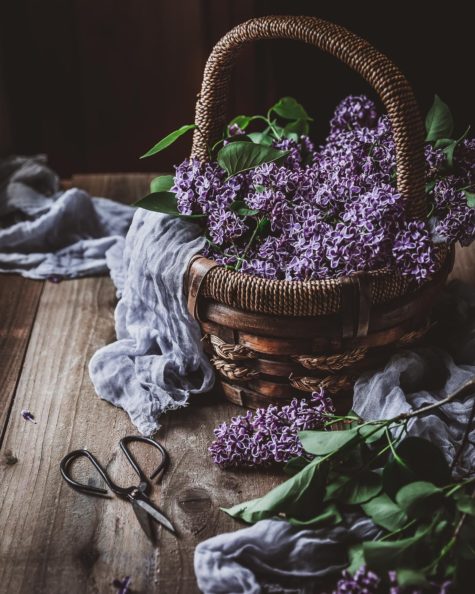
Magickal Uses
- Part used: Fresh flowers
- Planet: Venus
- Element: Earth
- Magickal Influences: Love and Purification
This is the flirt flower. It attracts love quickly although the love it brings often doesn’t last for long. Wear the fragrance or bathe in fresh lilacs when you want a fling. This flower is for fun. It is a great scent to spray in a room before parties or before meeting a date who is taking the relationship too seriously. Lilac keeps things light.
Inhale the aroma rising from the light purple flowers for internal purification. To cleanse a home, place jars of the fresh flowers in several rooms. Bathe in Lilac dew on May Day for a year of beauty.
The scent of fresh lilac flowers was once thought to drive away ghosts.
The scent of lilacs enhances a child’s educational aptitude. Here are a number of ways to use it:
- Place a drop of lilac fragrance oil on a light bulb near where a child studies.
- Place a vase of fresh lilac blossoms on the child’s desk so that the fragrance wafts over the child while studying.
- Place a table and chair outside next to a lilac bush in bloom and send the child outside to study.
Like many flowers, lilacs can be utilized in love expansion rituals. The sweet fragrance of these seasonal blooms brims with loving energies.
In aromatherapy the fragrance of Lilacs is recommended to patients who suffer from chronic depression and anxiety. Lilac blossoms can be added to your bath for a soothing aromatherapy remedy for stress and anxiety.
No true lilac essential oil is currently available, however lilac scents are available. They are said to bring peace and harmony. Also believed to induce “Far Memory” or the ability to remember past lives. It is also useful for inducing clairvoyant powers in general.
Lilac oil reputedly repels vampires and is certainly more fragrant than garlic. Most of the Lilac oil that is commercially available is synthetic; presumably vampires can tell the difference. If you make your own, the lingering aroma should keep the vampire out of the house as well.
A recipe for how to make your own lilac oil can be found here: Oil of Lilac
Jennifer Shepherd at the Lipstick Mystic recommends using the seasonal qualities of lilacs as a way of jump-starting your life. She says,
“Since lilac tends to be one of the earlier flowering plants each spring-time, it carries with it some of the same spiritual energies of other “early bloomers” like daffodils and forsythia. Lilac has the same quality of being able to push or penetrate through harsh, heavy “winter” energies.
So if you’re seeking some kind of significant breakthrough in your life, and you want a little extra kick or punch to help get you through, connecting with the energies of lilac can be very helpful. Smelling the fresh flowers on the bush or bringing a few blooms inside to enjoy is the best way to connect with this special plant.”
Lilac blossoms are natural astringents–they dry things out. Place a cup or two of slightly wilted flowers in a jar, and fill with witch hazel. Allow it to steep for a few days, and then strain out the flowers. Use the lilac and witch hazel blend as a facial toner, to keep your skin looking healthy and fresh all summer. Dab a bit on your wrists when you’re getting ready to go out, to attract new love your way.
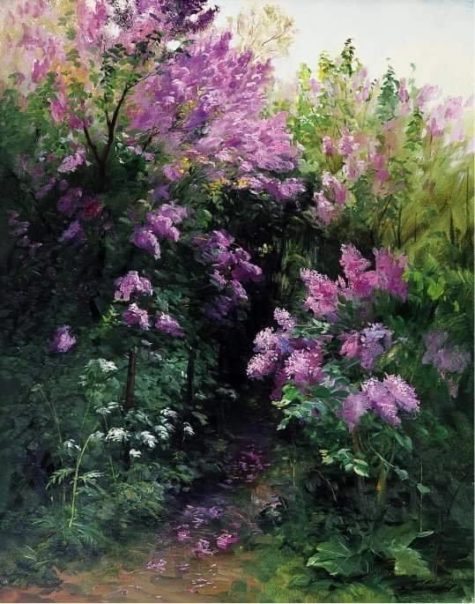
The Lore of Lilacs
The trees were respected by Orthodox Christians and the plant’s Greek name “pashalia” is derived from “pasha” which in Jewish means “passage” as they were considered to drive ghosts away instantly. The lilac tree is also linked with reincarnation.
One of the plant’s secrets is that the flowers do not fade under hot water. Lilacs are said to remove ghosts, aid the exploration of past lives, and bless the passages of life, both birth and death. Purple lilacs are the symbol for the first emotions of love. If the blossoms are strewn about it is said they can ward off evil.
Lilacs have a history of promoting clairvoyance, divination, peace, harmony and creativity. Lilac tonics were probably first introduced in Henry 8th time. They are called a harbinger of spring. White lilacs are a symbol of innocence.
In some parts of England, it is considered unlucky to bring Lilac, especially white Lilac, into the house. The purple and red varieties are usually less feared, but even they are sometimes excluded from house decorations as bringers of misfortune.
In the 1960’s, a florist in Oxford England strongly advised a customer not to buy white Lilac for a friend in the hospital on the grounds that many people thought it foretold death if brought indoors. He did not know why this should be so, only that it was quite commonly believed. In fact it is almost certainly due to the widespread association of death and misfortune with “drowsy-scented” flowers, and also with those which are white.
An interesting detail about the Lilac tradition is that it is found only in some English districts, especially in the midland counties, and quite unknown elsewhere.
It is lucky to find a five-petaled lilac blossom of any color. Along the Welsh border, Lilac trees are said to mourn if any of their kind are cut down, and to be flowerless in the following year.
From the Cincinnati Enquirer 1 August 1900, we have this fun little tidbit:
“She who wears the lilac will never wear the wedding ring,” runs the old proverb, and although the scent of the flower is sweet and its tints are fresh and universally becoming it is contraband among the village maidens in England.
A single boutonniere of lilac has been held responsible for solitary spinsterhood. For the same reason mothers with marriageable daughters never allow a jug of the sweet smelling blossoms inside the house. It may stand on the outside window sill, but “there’s no love luck about the house” when there are lilacs in it.
To give one’s sweetheart a spring of the flower is the death blow to the most secure of engagements. White lilacs are even more fatal to love affairs than the colored ones; they are, in fact, as ominous as an opal ring. Love, however, laughs at artificial flowers, and only the real tree grown one can come between the lover and his lass.
Stony-hearted bachelors sometimes sport a lilac boutonniere as a charm against feminine blandishments. Londoners do not share the superstition, and use the flower freely for decoration, regardless of the unlucky attributes.
Queen Adelaide, consort of King William IV, was apparently unafraid of lilacs, although, to be fair, she was already married when she commissioned her famous Honiton lace dress whose flower patterns, included lilacs, spelled out her name.
The meaning of the lilac flower has diversified throughout the ages. Lilacs originated in Southeastern Europe and are a popular part of the Mediterranean culture. They are frequently associated with the Easter holiday, which occurs during the peak of its bloom time.
Lilac meanings vary throughout different cultures and time periods.
- The Celtics regarded the lilac as “magical” due to their incredibly intoxicating fragrance.
- During the Victorian Age, the giving of a lilac was meant to be a reminder of an old love. In fact, widows were often seen wearing lilacs during this period.
- In Russia, holding a sprig of lilac over the newborn would bring wisdom.
- In the United States, the lilac is the official state flower of New Hampshire and represents the ‘hardy’ nature of its people.
Because lilacs have one of the earliest bloom times, they symbolize spring and renewal. Lilacs also symbolize confidence, which makes them a traditionally popular gift for graduates. There are many meanings that lilacs have that can best be classified by color.
- White lilacs symbolize purity and innocence.
- Violet lilacs symbolize spirituality.
- Blue lilacs symbolize happiness and tranquility.
- Magenta lilacs symbolize love and passion.
Lilac, the color for which this flower is named, is a light purple that symbolizes a first love.
Although various colors of lilacs have different meanings, the lilac has always had a strong association with love and romance throughout history.
Dreaming About Lilacs
Lilac in a dream is a sign of future changes in personal life, the anticipation of big feelings and an exciting love affair.
- White lilac personifies purity, sincerity, sensuality, the birth of affection.
- Violet lilac is a longing for love experiences, yearning of the heart; awakening of romance.
To dream of a blooming lilac is a sign of positive emotions, receiving pleasant news or surprise.
Standing under lilac bush in a dream promises a person a frivolous sexual adventure, which will very quickly exhaust itself, and feelings will evaporate before they turn into something serious.
Miller’s dreambook positioned dreams about lilac mainly as a good sign, foreshadowing love experiences, romance, a surge of sensuality. Flowering lilac shrub reflects the kind and open attitude of people around them to the dreamer, trust and sympathy. Tearing lilac shows a greater likelihood to achieve the desired.
A bouquet of lilac is a sign showing opportunity to find something new about your beloved person, to have sincere conversation. The image promises a romantic acquaintance for single people, but this union will not be long-lasting.
For people who have been married for a long time, a bunch of lilac flowers speaks about the revival of long-forgotten romantic feelings between spouses – sexual desire will be restored and a seemingly past, withering passion will appear.
Some dreambooks interpret ambiguously dreams of a lilac branch. To see a torn off branch in a dream is a symbol of illusion, deceptive hopes that will never be realized. One should beware of strangers who sincerely offer friendship at first glance. To see the blossoming branch of a lilac bush from a window in a dream promises pleasant pastime and an unexpected gift.
To see lilac in a dream and feel its scent means an extraordinary, almost mystical attraction to a person of the opposite sex. Dream interpretation advises not to succumb to this feeling (which will be very difficult to do), because the fruits of such intrigues will remind of themselves more than once, and can easily ruin the life of even the most self-confident person.
If the dreamer happened to pick the fragrant lilac in a dream, it means he will attract close attention of a person whom he likes for a long time.
To dream of a lilac flowers represents feelings about how beautiful it is to notice never fearing a sense of accomplishment in something that isn’t dependent on anything else. A sense of accomplishment in something that nobody else wants to do that always cares about your feelings. Feeling good noticing yourself successful from being self taught. Feeling good about your children having grown up to be independent never needing you for anything.
Sources:
- Encyclopedia of Herbology
- Mrs Daffodil Digresses
- Magical Aromatherapy
- The Encyclopedia of Superstitions
- Encyclopedia of Magickal Ingredients
- Magical Herbalism
- Element Encyclopedia of 5000 Spells
- FTD by Design
- Check My Dream
Magickal Uses
- Planet: Sun, Venus
- Ruler: Pan, Astarte
- Element: Water, Fire
- Astrological Sign: Taurus
- Parts Used: Dried Root
- Basic Powers: Love, Purification
Lovage is one of the most dependable herbs for drawing romance into one’s life. Not only will it bring you love, but regular bathing with this herb will enhance your beauty, physically, and will also allow the inner radiance to shine forth more brightly.
For this reason, Lovage is often used as a bathing herb, cast into the bath, the pleasant scent filling the room and delicately scenting the bather. In this manner, particularly when combined with a candle and poems of a romantic nature, is one able to attract romance.
Add seven rose buds to a Lovage bath, and you will become more attractive to the opposite sex.
With a subtle floral scent, the root is an effective addition to Herbal Amulets to attract love, and it can be steeped in wine to be served to a prospective lover.
You can also add the root, or a strong tea made by boiling the root, to a bath to become psychically cleansed.
In Central Europe, women wore Lovage around their necks when meeting lovers, and the herb was often put in love potions as a guarantee of everlasting devotion.
To encourage someone to love you more, the following can be done:
For nine successive days, rise early, boil Lovage root in water to make a tea, hand-bathe your genitals and face in this before dawn, carry the wash basin to a crossroads, call the name of the one you love, and throw your used bath water toward the sunrise.
One of the most nonjudgmental of herbs, Lovage draws the person most suited to your soul. A great root for bisexuals or anyone confused about which gender he or she is (or should be) attracted to. It is best used when invoking a new relationship and promises to quickly attract your heart’s desire.
Plant Lovage in front of and around your home to help ward off all sorts of unwanted intruders, ranging from door-to-door salespeople, to evil spirits, to epidemics, to vermin.
The leaves can be placed in the shoes to relieve weary feet.
Lovage dug up at night on Good Friday reputedly helps ward off either witches or the influence of the Devil.
Folk Names
- Bo’ Hog Root
- Gout Weed
- Italian Parsley
- Lavose
- Love Root
- Lubestico
- Sea Parsley
- Smellage
History and Folklore
The history of Lovage goes back to the ancient Greeks who chewed the leaves for digestion and gas. Both the Greeks and the Romans used the herb as a medicine, and in the Middle Ages it was used as a cure-all for most illnesses.
- The seeds were nearly as expensive as black pepper at one time.
- Hildegard of Bingen used Lovage in her cooking.
- John Gerard believed Lovage was one of the best remedies of his time (mid 1500s).
Lovage has an ancient history. It was introduced into Britain by the Romans and brought here by early English colonists and was often found in their gardens. Lovage was one of the seeds found in the early American Shakers’ seed sales.
As both a medicinal and culinary herb, Lovage now grows in the authentic garden at Plimoth Plantation, the re‐creation of a Pilgrim village in Plymouth, Mass.
New Englanders would candy the root and chew on the seed during long church services to keep them alert.
Colonial women “cured” many ailments with Lovage: sore eyes, upset stomach. They used fresh leaves for summer “sallets” and flavored winter soups, with the dried root. The dried leaves seasoned the stuffing for roast goose or turkey.
Sources:
- Encyclopedia of Herbology
- The Master Book of Herbalism
- The Herb Book by John Lust
- The Complete Book of Herbs and Spices
- Hoodoo Herb and Root Magic
- Magical Herbalism
- The Herbal Academy
- The Herbal Alchemists Handbook
- Element Encyclopedia of 5000 Spells
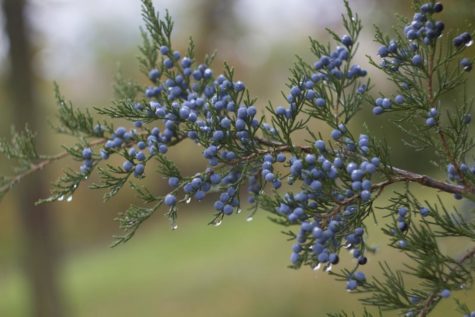
- Ruler: Sun
- Magickal form: Incense, fresh sprigs, berries, essential oil
- Basic Powers: Protection, Love, Healing, Cleansing
- Cautions: Do not drink the tea if you are pregnant, wish to become pregnant, or if you have kidney disease.
In the past, Juniper was regarded as a magick shrub to use against devils, evil spirits, and wild animals. It is mentioned in the Bible as a symbol of protection. Its aromatic scent made it a popular strewing herb, and shoots were burned to disinfect the air in a room.
Brew the berries into a tea and drink it to increase sexual stamina. Crush dried berries to release their scent and add to love potions to attract a man. String the matured berries for an attractive charm designed to attract lovers.
Juniper berries can be used in love spells, particularly to enhance male interest and potency. Steep in wine and drink a few sips daily to increase male virility. Steep in vinegar and add it to your bath to make yourself more attractive to men or apply it directly to the genitals (diluted with water) to increase male interest in them. Or add it to a bath you’re sharing. Juniper berries and their essential oils make for a nice “masculine” scent for men’s cosmetics (aftershave, beard oil, etc.). Use with due caution.
Hang a sprig of fresh Juniper in the home to drive away evil. A sprig of Juniper will protect the wearer from accidents. Sometimes used in anti-theft sachets, as it guards against thieves. Grow Juniper at your doorstep for protection. Gin (which is made from Juniper) can be sprinkled across a threshold to guard against theft.
Juniper is a thief catcher. If you bend a young Juniper branch down to the ground and hold it where you place it with two weights, one a big stone, the other the skull of a murderer, and say, “Juniper, I bend and squeeze you till the thief (name him) returns what he has taken to its place,” the culprit will feel an unaccountable impulse to return the property.’
Brush down the body with a bundle of sprigs to remove illness and place drops of oil in a bowl of water to promote healing in a sick room. Burn Juniper for purification and good health. One of the earliest incenses used by Witches was made from a combination of the leaves and the dried crushed berries.
Though burning Juniper wood gives off only minimal visible smoke, this smoke is highly aromatic, and in ancient times it was used for the ritual purification of temples. The smoke was said to aid clairvoyance, and continued to be burned for purification and to stimulate contact with the Otherworld at the autumn Samhain fire festival at the beginning of the Celtic year.
In central Europe Juniper smoke played a part in the spring-time cleansing and casting out of witchcraft. Juniper was also burned during outbreaks of the Plague, and in Scotland the disease could be dispelled by fumigating the house with Juniper smoke while its occupants were inside, after which the house was aired and the occupants revived with whisky!
Juniper was burned to goddesses and gods in ancient Sumer and Babylon, and was widely used in Egyptian incense formulas. It was sacred to Inanna and her later counterpart Ishtar. Many centuries later in Europe, branches of Juniper were smoldered and carried around fields and farms to release protective energies and guard livestock and crops.
It is a common ritual incense ingredient in Tibet and was much used by various Native American groups.
It is said that a Juniper shrub or tree is a particularly effective and magical hiding place. Perhaps Juniper can be added to hiding and invisibility charms as well.
Juniper essential oil is currently used in traditional aromatherapy to detoxify the body, as a parasite destroyer and antiseptic. This seems in keeping with the “magickal” use of purifying homes and fields mentioned above, for protective rituals are designed to ward off negativity as well as to purge such energies from a person or place.
Inhale Juniper essential oil while visualizing its energies guarding you from negativity and danger. Or, for an internal purification, smell Juniper and visualize.
You can also make Juniper a part of health-maintaining rituals. Regularly smell the scent while seeing yourself eating correctly, exercising, and thinking positively.
Notes:
Because it is a variety of Juniper, and the magickal uses are quite similar, Eastern Red Cedar can be used as a substitute, and vice versa. More about Red Cedar can be found here.
A Healing Ritual
There was a folk medicine custom in some parts of the South West of England of burning the wood and needles close to a sick person. This practice is closely allied to the above New Year customs and presumably recognizes that the vaporized oil released into the air had some beneficial purifying effect to dispel infection.
Like many plants, there was a definite ritual which had to be followed when pulling or collecting Juniper so that the power and essence of the plant was not lost. In the case of Juniper, it had to be pulled up by the roots, the branches made into four bundles and held between the five fingers while intoning the appropriate incantation. Unfortunately the version which has been passed down to us has been heavily Christianised:
“I will pull the bounteous yew,
Through the five bent ribs of Christ,
In the name of the Father, the Son and the Holy Ghost
Against drowning, danger and confusion.”

Juniper Mythology and Lore
Juniper was a symbol of the Canaanites’ fertility goddess Ashera or Astarte in Syria. In the Bible’s Old Testament, a Juniper with an angelic presence sheltered the prophet Elijah from Queen Jezebel’s pursuit. Similarly a later apocryphal biblical tale tells of how the infant Jesus and his parents were hidden from King Herod’s soldiers by a Juniper during their flight into Egypt.
Juniper plants are associated with protection in many different Native American tribes. The Interior Salish and Northwest Coast tribes used Juniper to banish evil spirits and protect themselves from witchcraft.
Among the southwestern Pueblos, junipers were believed to counteract ‘ghost sickness,’ a malady which afflicted bereaved relatives or people who handle the bodies of the dead.
Plains Indian tribes, such as the Dakota, Cheyenne, and Pawnee, often hung Juniper boughs on their tepees or burned them in the camp fire to keep their homes safe from storms.
And in many tribes people, especially hunters, would carry a spring of Juniper as a protective charm or rub Juniper branches on their bodies before embarking on a dangerous journey to protect themselves from grizzly bears, monsters, or general bad luck.
Juniper is one of the herbs frequently included in medicine bundles and amulets. Juniper berries were also eaten by people in some Southwestern and Southern California tribes, and Juniper leaves were frequently used as medicinal herbs.
Folk tradition records a divinatory significance to the appearance of Juniper in dreams, for:
- It is unlucky to dream of the tree itself, especially if the person is sick.
- To dream of gathering the berries, if it be in winter, denotes prosperity.
- To dream of the actual berries signifies that the dreamer will shortly arrive at great honors and become an important person.
- To the married it foretells the birth of a male child.
The largest body of folklore concerning Juniper comes from Iceland where it was traditionally believed that Juniper and rowan could not grow together because each creates so much heat that one or other of the trees would be burn up. For the same reason it was considered not a good idea to bring sprigs of both woods into the house together unless you particularly wanted your house to burn down.
Another Icelandic belief has it that if you are building a boat, you must either use both Juniper and rowan wood or use neither of them in the boat, otherwise it will sink.
In Wales it was said that anyone who cut down a Juniper tree would be dead within a year, while in Newfoundland it was believed that wolves and bears are repelled by Juniper wood and for this reason people who kept stock would ensure that Juniper wood was used in building enclosures or stockades in which livestock would be kept.
Also in Newfoundland it is believed that you will always find water under a Juniper tree, though this seems to contradict the natural history of Juniper which, as mentioned above, generally grows best on limestone or chalk soils which are usually well-drained.
The Story entitled Red Riding Hood in the book The Hero of Esthonia tells of a mother laying down Juniper branches and making the sign of the cross over them to protect her sleeping children from devils. In the story The Compassionate Shoemaker in the same book, the devil is defeated by being struck by a staff of Juniper.
In the Argonautica, Medea uses a freshly cut spray of Juniper to sprinkle her sleeping potion into the eyes of the serpent guarding the Golden Fleece.
- Meaning and history of the name Juniper:
From the Latin, juniperus which means “youth producing” or “evergreen.” During the Renaissance era, Junipers were used symbolically in art to represent chastity. Juniper has historically been used as both a boys and girls name, in fact Saint Juniper and Thornton Wilder’s character Brother Juniper are both male.

The Juniper Tree – A Story
“The Juniper Tree” is a German fairy tale collected by the Brothers Grimm. The text in the Grimm collection is in Low German and was originally written down by the painter Philipp Otto Runge. The complete story as originally written can be found over at Widdershins.
Here is a synopsis:
A wealthy and pious couple pray every day for God to grant them a child. One winter, under the Juniper tree in the courtyard, the wife peels an apple. She cuts her finger and drops of blood fall onto the snow. This leads her to wish for a child to be as white as snow and as red as blood. Six months later, the wife becomes gravely ill from eating Juniper berries and asks her husband to bury her beneath the Juniper tree if she dies.
A month later, she gives birth to a baby boy as white as snow and as red as blood. She dies of happiness. Keeping his promise, the husband buries her beneath the Juniper tree. He eventually marries again and he and his new wife have a daughter named Marlinchen (in some versions Marlene, Marjory or Ann Marie).
The new wife loves Marlinchen but despises her stepson. She abuses him every day, claiming that she wishes Marlinchen to inherit her father’s wealth instead of her stepson. One afternoon after school, the stepmother plans to lure her stepson into an empty room containing a chest of apples. Marlinchen sees the chest and asks for an apple, which the stepmother gracefully offers. However, when the boy enters the room and reaches down the chest for an apple, the stepmother slams the lid onto his neck, decapitating him.
The stepmother binds his head with the rest of his body with a bandage and props his body onto a chair outside, with an apple on his lap. Marlinchen, unaware of the situation, asks her stepbrother for an apple. Hearing no response, she is forced by her mother to box him in the ear, causing his head to roll onto the ground.
Marlinchen profusely cries throughout the day whilst the stepmother dismembers the stepson’s body and cooks him into a “blood-soup” for dinner. She later deceives her husband by telling him that his son stayed at the mother’s great uncle’s house. The husband unwittingly eats the “blood-soup” during dinner and proclaims it to be delicious. Marlinchen gathers the bones from the dinner and buries them beneath the Juniper tree with a handkerchief.
Suddenly, a mist emerges from the Juniper tree and a beautiful bird flies out. The bird visits the local townspeople and sings about its brutal murder at the hands of its stepmother. Captivated by its lullaby, a goldsmith, a shoemaker and a miller offer the bird a gold chain, a pair of red shoes and a millstone in return for the bird singing its song again. The bird returns home to give the gold chain to the husband while giving Marlinchen the red shoes.
Meanwhile, the stepmother complains about the “raging fires within her arteries”, revealed to be the real cause of her anger and hatred towards her stepson. She goes outside for relief but the bird drops the millstone onto her head, killing her instantly. Surrounded by smoke and flames, the son, revealed to be the bird, emerges and reunites with his family. They celebrate and head inside for lunch, and live happily ever after.
Sources:
- Encyclopedia of Herbology
- Plant Lore
- Trees For Life
- Witchipedia
- White Dragon
- Encyclopedia of Magickal Ingredients
- The Herb Stop Blog
- Magical Herbalism by Scott Cunningham
- Magical Aromatherapy by Scott Cunningham
- Basic Powers: To achieve long-term goals or help lost causes.
- Pronunciation: “now-these”
For all forms of success and all types of achievement. However, remember that a gift, and take note of the associated god. Useful for harnessing internal power, intuition and creativity, the ability to achieve, as with a sudden rush of adrenaline or creation of momentum. The fourth of Odin’s runes frees one from locks and fetters, which ties in well with the meaning of Nauthiz.
This rune has two aspects and you would do well to remember them when formulating your runescript. Nauthiz represents need and distress but also the release from that distress. Through the utilization of this rune by the will, one can change Fate via knowledge and wisdom. This rune is a very powerful rune in Icelandic love magick and represents the primal needs and desires that drive you to seek out a lover. Overcoming distress. Achieving your goals. Protection. Love magick and to find a lover. Impetus to get a relationship off the ground.
Overcoming distress or negative energy. Development of magical will. Development of “spiritual” powers. Protection. Use of the force of “resistance” under will toward magical goals. Sudden inspiration. Eliminates hate and strife. Creates a need for order. Recognition of personal need. Love magic–to obtain a lover. Divination.
The Chant
naudhiz naudhiz naudhiz
n n n n n n n n n
nu na nu ne no
nudh nadh hudh nedh niodh
(nut nat nit net not)
un an in en on
n n n n n n n n n
It can be used in conjunction with the symbol, or chanted while visualizing the symbol. The symbol can be etched into a candle while intoning the chant, and then, as the candle burns, the spell is released and sent.
The Statement of Intent
Need is the manifestation of desire;
the bondage of will to the external object.
It can be oppressive
but it can also be the key to liberation.
In organizing with others
bonds of oppression can be broken.
This is a modern version of the “Rune Poem” that defines this particular rune. It can be used in combination with the chant, and while creating a talisman or spell that uses the power of this rune.
Runic Posture
Rune Yoga, or Runic postures are used to anchor the energy of the Rune in your physical body. More about them can be found here: Runic Postures.
Assume the recommended runic posture and sing the name of the rune in a non-exhaustive way that you can feel your body vibrating – in magic literature it is called vibrating. It could be that you can hear overtones clearer as usual during vibrating. Take this as a good sign. You are visualizing the rune with your inner eye, as its form is being represented by your body and the energies are flowing through your body.
Stand up, with the right arm raised to the right and the left arm inclined to form a straight line with the right one.
Before practicing a rune it is recommended to know everything on the powers of the rune you want to practice. The flow of energy is different for each rune, a field of research for your sensitivity.
The hand positions, or mudras are effective only after you have anchored the runes in your own aura and body. They can be made silent and unobtrusive.
Sources:
-
- Understanding Runes
- Asatru
- Futhark
- Flight of the Condor
- A Practical Guide to the Runes
- Esoteric Rune Magic
- Image from Deep Earth Arts
- Basic Powers: To create harmony in personal relationships.
- Pronunciation: “gay-boe”
Propitiation; removal of a curse (or karmic debt) through a sacrifice which brings with it right intention and action. A sign under which gifts can be made to the gods. Of Odin’s eighteen runes, the last is secret. It could be the secret of sacrifice.
Gebo (or Gifu) is the rune of partnerships in all realms. It contains the power to integrate the energies of two or more people in order to produce a force that is greater than the sum total of their individual parts. It is the primary rune of sex magick. Love and sex magick. Increase magickal powers. Anything to do with partnerships. Mental and physical equilibrium.
Sex magic. Sex magic initiation. Mystical union. Increase in magical powers. Harmony between brothers and sisters and lovers. Acquisition of wisdom.
The Chant
gebo gebo gebo
gu ga gi ge go
gub gab gib geb gob
og eg ig au ur
g a a a f f f f f
It can be used in conjunction with the symbol, or chanted while visualizing the symbol. The symbol can be etched into a candle while intoning the chant, and then, as the candle burns, the spell is released and sent.
The Statement of Intent:
The giver and the giftee
form a circle of obligation.
As these are the bonds
which form true community.
Tho one can give too much
and receive that which one doesn’t want.
This is a modern version of the “Rune Poem” that defines this particular rune. It can be used in combination with the chant, and while creating a talisman or spell that uses the power of this rune.
Runic Posture
Rune Yoga, or Runic postures are used to anchor the energy of the Rune in your physical body. More about them can be found here: Runic Postures.
Assume the recommended runic posture and sing the name of the rune in a non-exhaustive way that you can feel your body vibrating – in magic literature it is called vibrating. It could be that you can hear overtones clearer as usual during vibrating. Take this as a good sign. You are visualizing the rune with your inner eye, as its form is being represented by your body and the energies are flowing through your body.
The traditional posture calls for the left arm and right leg to be extended in matching 45° angles, placing the body at a slant. The right arm is bent at the elbow with the fingers and hand pointing upward, and the left leg is bent at the knee, stabilizing the body. This posture is based on a slightly different rune shape, which can be seen on the left side of the figure.
 An alternative posture based on the more familiar form of Kenaz is as follows:
An alternative posture based on the more familiar form of Kenaz is as follows:
Stand up with legs spread, feet straight and knees firm. Extend the arms at an angle that forms the X, with the hands directly above the feet.
Before practicing a rune it is recommended to know everything on the powers of the rune you want to practice. The flow of energy is different for each rune, a field of research for your sensitivity.
The hand positions, or mudras are effective only after you have anchored the runes in your own aura and body. They can be made silent and unobtrusive.
Sources:
- Understanding Runes
- Asatru
- Futhark
- Flight of the Condor
- A Practical Guide to the Runes
- Esoteric Rune Magic
- Image from Deep Earth Arts
- Basic Powers: To restore self-confidence and strengthen will-power.
- Pronunciation: “cane-awze”
Kenaz is useful for spiritual understanding, initiation, the harnessing of power, and guardianship. It can be used to bring strength to an individual, or for the banishment of dark forces of any kind. It can help overcome obstacles through learning. It is also a good luck charm. It is not, however, any good for combat. It banishes the dark but it doesn’t defeat it.
Kenaz is another rune of Fire, but unlike Fehu, it is a gentle, more controlled form which gives the ability and the will to create. It is the rune of the artist and craftsman and is useful either when creativity is the issue or when artistic things are very important to the person for whom you are creating the runescript. It also governs the technical aspects of magick. It is the rune that governs passion, lust and sexual love as fiery, positive attributes. Use to strengthen any runescript. Healing, physical well-being. Love, stability and passion in relationships. Fresh starts. Protection of valuables.
Strengthening of abilities in all realms. Creative inspiration. Higher polarization as a tool of operation. Operations of regeneration, healing. Love (especially sexual love).
The Chant
kenaz kenaz kenaz
ku ka ki ke ko
kun kan kin ken kon
ok ek ik ak uk
kaunnnnnnnnn
It can be used in conjunction with the symbol, or chanted while visualizing the symbol. The symbol can be etched into a candle while intoning the chant, and then, as the candle burns, the spell is released and sent.
The Statement of Intent:
The inner light which is never extinguished
brightens the dark weary world.
This body is a great hall;
the mind sits in the body’s high seat.
The call to faith
a torch carrying procession.
This is a modern version of the “Rune Poem” that defines this particular rune. It can be used in combination with the chant, and while creating a talisman or spell that uses the power of this rune.
Runic Posture
Rune Yoga, or Runic postures are used to anchor the energy of the Rune in your physical body. More about them can be found here: Runic Postures.
Assume the recommended runic posture and sing the name of the rune in a non-exhaustive way that you can feel your body vibrating – in magic literature it is called vibrating. It could be that you can hear overtones clearer as usual during vibrating. Take this as a good sign. You are visualizing the rune with your inner eye, as its form is being represented by your body and the energies are flowing through your body.
The traditional posture calls for both arms to be raised at a 45º angle, palms up and open to receive. This posture is based on a slightly different rune shape, which can be seen on the left side of the figure.
 An alternative posture based on the other form of Kenaz is as follows:
An alternative posture based on the other form of Kenaz is as follows:
Stand up, with your right arm raised at a 45º angle and your left arm tilted down at an equal angle. The palm of the right hand looks towards the law, attracting the force, while the fingers of the left hand are extended, projecting towards the manifestation.
Before practicing a rune it is recommended to know everything on the powers of the rune you want to practice. The flow of energy is different for each rune, a field of research for your sensitivity.
The hand positions, or mudras are effective only after you have anchored the runes in your own aura and body. They can be made silent and unobtrusive.
Sources:
- Understanding Runes
- Asatru
- Futhark
- Flight of the Condor
- A Practical Guide to the Runes
- Esoteric Rune Magic
- Image from Deep Earth Arts
- Basic Powers: For protection and defense.
- Pronunciation: “thoor-ee-saws”
Thorn (Thurisaz) is useful for attack and sometimes for tests. It makes people careless at the wrong moment; it makes people sicken; it drives people insane. It is particularly suitable for increasing the fear of people already afraid. Of Odin’s list of eighteen runes, the sixth turns an enemy’s spells against them.
In the poem the spell is stated to be the root of a sapling with runes cut into it.
Directed cosmic power of defense. It symbolizes Mjollnir, the Hammer of Thor. It is pure will untempered by self-consciousness. It is a projectable form of applied power. The force of Thurisaz is able to direct their energies in an effective fashion. Use it when a “little something extra” is required to get things off the ground. New beginnings. Use when you need luck or when circumstances are beyond your control. Protection or defense. Neutralization of enemies or opposition. To push the issue in love magick.
Defensive (active). Destruction of enemies, curses. Awakening of the will to action. Preparedness for generation in all realms. Love magic. Knowledge of the division and unity of all things.
The Chant
thurisaz thurisaz thurisaz
th th th th th th th th th
thur thar thur ther thor
thu tha thu the tho
th th th th th th th th th
It can be used in conjunction with the symbol, or chanted while visualizing the symbol. The symbol can be etched into a candle while intoning the chant, and then, as the candle burns, the spell is released and sent. Traditionally, the rune would be carved into the root of a sapling while chanting and visualizing the desired outcome.
The Statement of Intent:
Computers crash
and planes fall out the skies.
That is the nature of things
and not always evil in intent.
Even good people sometimes cause
good people harm.
This is a modern version of the “Rune Poem” that defines this particular rune. It can be used in combination with the chant, and while creating a talisman or spell that uses the power of this rune.
Runic Posture
Rune Yoga, or Runic postures are used to anchor the energy of the Rune in your physical body. More about them can be found here: Runic Postures.
Assume the recommended runic posture and sing the name of the rune in a non-exhaustive way that you can feel your body vibrating – in magic literature it is called vibrating. It could be that you can hear overtones clearer as usual during vibrating. Take this as a good sign. You are visualizing the rune with your inner eye, as its form is being represented by your body and the energies are flowing through your body.
Standing with the left arm bent at the elbow and the left hand palm up. The right arm is bent at the shoulder with the right palm down. The two hands meet in the middle. Look to the east or to the south.
Because the traditional position seems almost impossible to accomplish, here is a much more comfortable variation. Stand up, with the left arm bent at the elbow and the palm on the hip. The right arm should be firmly attached to the side. Look to the south. As shown in the small pic, your body will resemble the shape of the rune.
Before practicing a rune it is recommended to know everything on the powers of the rune you want to practice. The flow of energy is different for each rune, a field of research for your sensitivity.
The hand positions, or mudras are effective only after you have anchored the runes in your own aura and body. They can be made silent and unobtrusive.
Sources:
- Understanding Runes
- Asatru
- Futhark
- Flight of the Condor
- A Practical Guide to the Runes
- Esoteric Rune Magic
- Image from Deep Earth Arts
- Ruler: Dionysus
- Type: Plant
- Sign: Virgo
- Tarot Card: The Hermit
- Magickal Form: Flower, Essential Oil
The Narcissus is often assigned to the month of December, and is also associated with the Chinese New Year which occurs in February.
Wear this scent to entice others and promote self-love and self-confidence. Overuse can attract stalkers and create egomaniacs – so don’t over do it. Rub on pink candles to meet new people. Rub black Narcissus oil on black candles for self-hypnosis. Use the oil on red candles to hypnotize and bewitch another.
In China, for centuries, narcissus bulbs have been placed in bowls with rocks and water. They are then “forced” into flowering by the Chinese New Year to acquire good fortune.
This old-fashioned flower for late spring is famous for its fragrance, which is one of the most expensive in the world. The Romans made a perfume from this flower, and it featured in early Arab perfume as well. The scent is a combination of jasmine and hyacinth. Its fragrance affects the nervous system (Mercury again), relieving stress.
These beautiful flowers emit sweet, lovely fragrances long used to manifest new relationships or to enrich the love already shared with another. The purple varieties seem to be best for this use. In the Middle East, the scent is thought to be aphrodisiac.
Magickally, this old-fashioned flower is dedicated to virgins, hermits, those who practice a solitary spirituality, and people who just enjoy being alone. Reasonably, it is connected to the sign of Virgo and the Hermit card. Venus bathed in narcissus flowers before winning a contest of beauty against Juno and Diana, but the plant is sacred to Adonis.
You would think then that this magick herb would be associated with the Sun, but instead it is considered a Mercury herb. Its name comes from the word for “stuck dumb” due to the power of its poisons to take away speech, which Mercury rules. Narcissus is specific for Mercury magickal works, such as those leading to parthenogenesis and invisibility.
Narcissus vs Daffodil
Though their botanic name is Narcissus, they are often also called daffodils, and sometimes jonquils, or paper whites. In England, because of their long association with Lent, they’re known as the “Lent Lily.”
The term “Daffodil” commonly refers to Narcissus with large trumpets, but may be used for all types of Narcissus . This is the official common name for ANY of the plants that fall into the genus Narcissus. So, if the plant is considered a Narcissus, it is also considered a daffodil as well. However, most people use the term “daffodil” when referring to the large, trumpet-shaped flowers of the Narcissus pseudoNarcissus .
- In Victorian flower language daffodils signified regard and chivalry, whilst the Narcissus meant self esteem, female ambition or vanity.
You can read more about the magickal properties of the Daffodil here: Daffodil Magick and Lore.
Narcissus in Mythology
The Narcissus is named after the legendary young Greek man of the same name. Narcissus was pretty full of himself because he had been given the gift of great beauty by the gods. One day, a sweet young wood nymph named Echo spotted Narcissus hanging out by a stream and instantly fell in love with him. However, he was so busy being completely self-absorbed that he ignored Echo, and she wasted away from loneliness until nothing was left of her but her voice. Thanks to this tragic story of unrequited love, the Narcissus is sometimes used to represent a love that is one-sided.
Later, the goddess Nemesis, although in some versions, it’s Venus, got wind of what had happened to Echo, so she decided it was time to teach Narcissus a lesson. She led him to a stream, where he happened to notice the most beautiful young man he had ever seen – it was his own reflection, and he was so vain that he fell in love with his own image, transfixed, and forgetting to eat and sleep. Some of the other gods were worried that Narcissus was going to starve to death, so they turned him into a flower, which now blooms every year in the spring.
- Alternatively
It is possible that this plant wasn’t named after the youth who fell in love with his reflection in a pool of water. Pliny states that the name was derived from the word “narkao, to benumb, due to the plant’s dramatic effects on the nervous system when taken internally. Never eat any part of this plant.
- Ruler: Sun, Apollo
- Type: Plant
- Magickal Form: Flowers, Vine, Leaves, Seeds
With it’s lovely flowers, heart shaped leaves, and clinging vine, the morning glory plant is definitely something to consider when constructing a love and/or relationship spell.
Grind morning glory seeds to a fine powder and add to flying incense to gain psychic sight.
In the language of flowers, the morning glory represents affection. As a gift, these beautiful flowers can be given in nearly any way imaginable – from the traditional bouquets to pressed or dried single blossoms. When given as an arrangement, you might also take color into account. That is to say, your message may generally express a feeling of affection, but that affection might be tinted with the fiery passion of a red blossom, the calm of a blue one, or the spirituality of a purple one.
In some cultures the ipomoea aquatica variety of morning glory is considered a delightful green that can be used in a number of dishes. They are frequently placed in salads, stir fries, mixed with noodles, or simply used as a garnish.
Although morning glory seeds are considered to be mildly toxic and have side effects such as hallucinations, nausea and drowsiness, many people still consider them to have powerful medicinal effects. The Aztec narcotic ololiuhqui, derived from a wild morning glory, was spread on surface of affected parts for gout, and the seeds were eaten by the Aztecs to bring visions. Their molecular structure resembles that of LSD. The seeds are sold in nurseries for planting.
- NOTE: Using the seeds as a hallucinogenic is not only illegal but they are harmful when ingested.
In China, the morning glory was once considered a highly effective laxative; to the native Indians of Mexico, both ipomoea tricolor and turbina corymbosa were frequently used in rituals and medicine for their supposed soothing properties.
In folk medicine, the boiled leaves of certain species are used as a diuretic; the seeds are chewed to aid in soothing stomach pains, while the whole plant may be cooked and turned into a topical ointment to treat rheumatoid arthritis. Morning glory tea was said to be good for dysentery and diarrhea.
According to Scott Cunningham (Encyclopedia of Magical Herbs) the morning glory or bindweed (Ipomoea spp) are masculine plants, classified as being under the influence of the planet Saturn; the element water, and with powers over happiness and peace.
Cunningham indicates that one can “Place the seeds beneath the pillow to stop all nightmares.” And also that grown in the garden, blue morning glories bring peace and happiness. The root of the morning glory, according to Cunningham, may be used as a substitute for High John the Conqueror root.
Sources:


